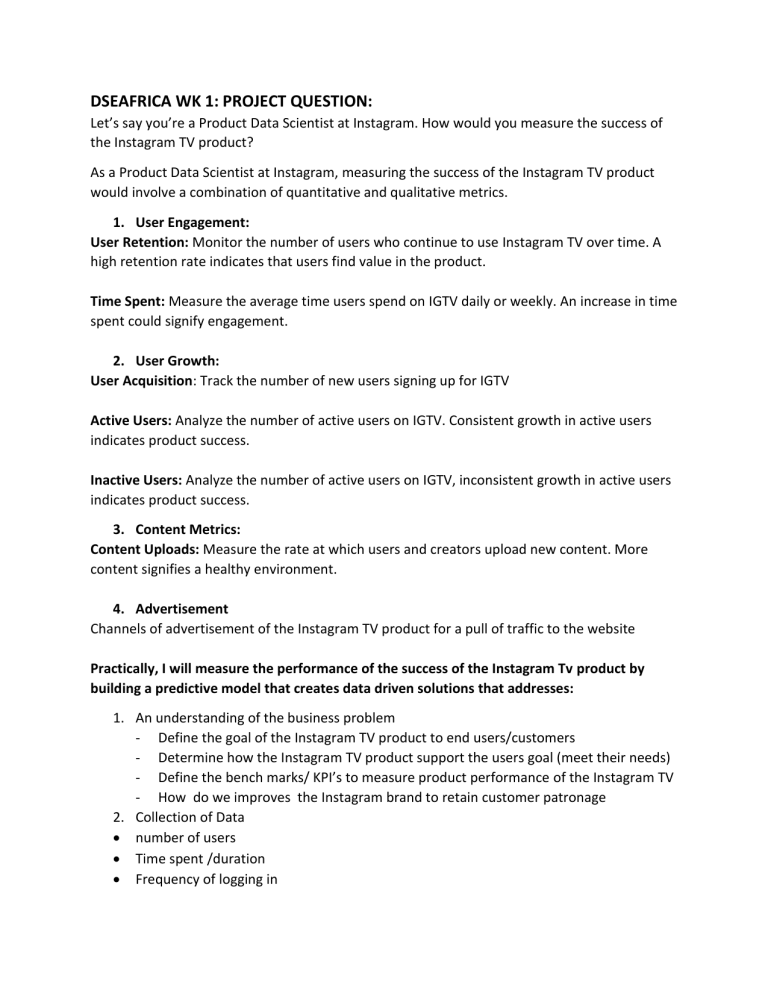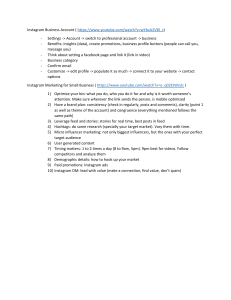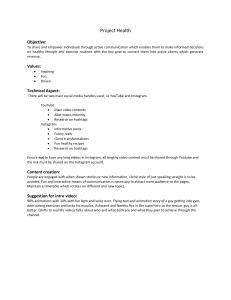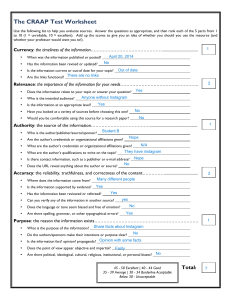
DSEAFRICA WK 1: PROJECT QUESTION: Let’s say you’re a Product Data Scientist at Instagram. How would you measure the success of the Instagram TV product? As a Product Data Scientist at Instagram, measuring the success of the Instagram TV product would involve a combination of quantitative and qualitative metrics. 1. User Engagement: User Retention: Monitor the number of users who continue to use Instagram TV over time. A high retention rate indicates that users find value in the product. Time Spent: Measure the average time users spend on IGTV daily or weekly. An increase in time spent could signify engagement. 2. User Growth: User Acquisition: Track the number of new users signing up for IGTV Active Users: Analyze the number of active users on IGTV. Consistent growth in active users indicates product success. Inactive Users: Analyze the number of active users on IGTV, inconsistent growth in active users indicates product success. 3. Content Metrics: Content Uploads: Measure the rate at which users and creators upload new content. More content signifies a healthy environment. 4. Advertisement Channels of advertisement of the Instagram TV product for a pull of traffic to the website Practically, I will measure the performance of the success of the Instagram Tv product by building a predictive model that creates data driven solutions that addresses: 1. An understanding of the business problem - Define the goal of the Instagram TV product to end users/customers - Determine how the Instagram TV product support the users goal (meet their needs) - Define the bench marks/ KPI’s to measure product performance of the Instagram TV - How do we improves the Instagram brand to retain customer patronage 2. Collection of Data number of users Time spent /duration Frequency of logging in 3. 4. 5. 6. Age range User Content interests Number of New Users sign up Number of Old users Log in Number of Active users Number of Inactive users Data cleaning, processing and determination of KPI’s Exploratory data analysis Model building and Graphical visualization evaluation Communication of model results against set KPI’s ARTICLE: Data Science for Beginners: 2023 - 2024 Complete Roadmap https://dev.to/k_ndrick/data-science-for-beginners-2023-2024-complete-roadmap-23dn Data Science is a field of study involving statistical tools and techniques to extract meaningful insights from data. In modern day business world, as it helps organizations make informed decisions based on logic and reason rather than intuition. The need for data science has become increasingly important in today's world due to the vast amount of data being generated by businesses, organizations, and individuals, it provides the tools and techniques to extract meaningful insights from this data, enabling informed decisionmaking essential for businesses to gain a competitive edge and improve their operations. It also plays a crucial role in addressing the need to make informed decisions. Data science involves a combination of statistics, mathematics, programming (SQL Python), and problem-solving; capturing data in ingenious ways; the ability to look at things differently; and the activity of cleansing, analyzing and interpreting data. Data science as a roadmap is a visual representation of a strategic plan designed to help learn about and succeed in the field of data science. Data Science Road map steps Learning data for a beginner involves learning the necessary tools and technologies, understanding the underlying concepts, practicing and implementing what was learned. Below is a step-by-step data science roadmap for beginners to help you get started on your pursuit. Step 1: Learning Structured Query Language (SQL) Structured Query Language is a programming language used for managing and manipulating data stored in databases. It is a critical skill that allows to retrieve, filter and aggregate various data. Step 2: Programming Language (Python, Java, Scala) Python are widely used in data science for data manipulation, visualization, and machine learning tasks. Build more skills in data structures (data types, lists, sets, tuples), searching and sorting algorithms, logic, control flow, writing functions and object-oriented programming, Also, Familiarity with using Git and GitHub-related elements such as terminals and version control. Step 3: Visualization Tool (Power BI/QlikView/Tableau) Learn visualization tool like Power BI, QlikView, or Tableau. These tools allow for the creation of interactive and visually appealing charts, graphs, and dashboards to communicate data insights. Step 4: Basic Statistics for Machine Learning Learning basic statistics for machine learning involves using algorithms to learn from and make predictions on data. Step 5: Machine Learning Algorithms There are many different algorithms adopted in machine learning such as decision trees, linear regression and k-means clustering with each characterized by different strengths and weaknesses. Step 6: Practice and Implementation Practice and implementation of what has been learned through projects, exercises to apply skills, participating in online communities and forums to learn from others and get feedback on work done. To improve on skills you can work on real-world data sets and utilize the tools and techniques learned to explore, visualize, analyze data and building your machine-learning models and testing them on different data sets. Data Science Jobs Roles Data scientists design and execute data-driven projects using technical skills to collect, process, analyze and visualize data to find patterns and make predictions. Data scientists use their skills to understand the stories hidden in large datasets (sets of information). They can also help organizations develop new strategies and make more informed decisions by analyzing data from multiple sources. Below are some of the most common ones: • Machine Learning Engineer • Data Engineers • Business Analyst • Statistician • Data Architect • Data admin • Data Scientist Conclusion This provides an insight into the world of data science as a fast-growing industry.



